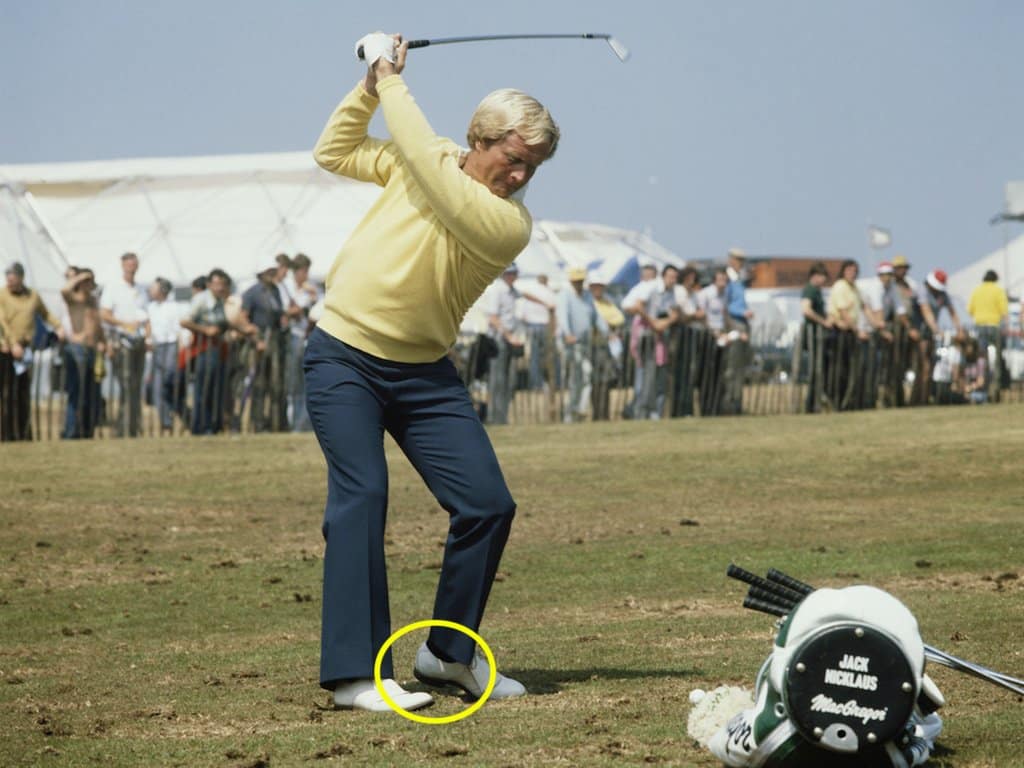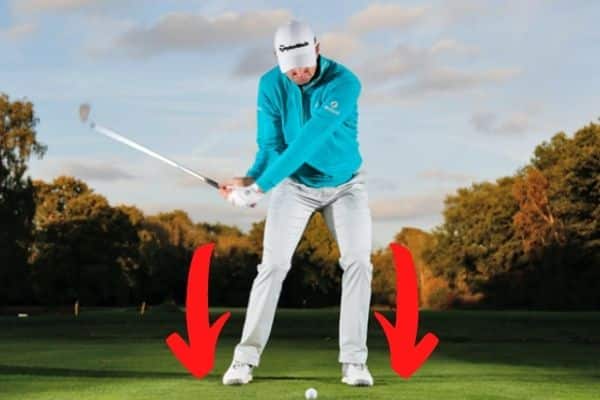The transfer of weight in the golf swing is something so many people get wrong, largely due to a range of misconceptions about which parts of the body should and shouldn’t move when playing a shot.
I’ve definitely suffered from these head worms myself: obsessing over the need to supposedly keep every part of the body stiff and rigid to avoid compromising plane and alignment, rather than letting things move fluidly without tension.
I now know this is completely wrong, and an appropriate amount of movement is required in several parts of the body – from the arms and head, down to the legs – in order to make a good swing.
Below are some articles that cover each of these elements in greater detail that I definitely recommend you read:
- Truth about keeping your left arm straight in golf
- Head position in golf: Should you keep it still?
- Power move: How to use your legs in the golf swing
But how much movement in your golf swing is the right amount? And how exactly should you transfer your weight during a shot?
In the golf swing, weight should be evenly distributed at address, slightly towards the balls of your feet. In the backswing, you should feel the weight shift onto the inside of your trail foot, before shifting forward again and through your left side when rotating through the shot.
The key here is to focus on the inside of the trail foot (right foot for a right hander) when shifting weight in the backswing, as this will help to avoid a sway or poor balance during the shot.
So why are people so worried about shifting around, particularly in their lower half, when hitting a golf ball?
It’s likely that most of this anxiety comes from a fear of swaying, something we are told – correctly so – can be detrimental to a golf swing (if you sway too much, read this).
Too much back and forward sway of the hips, rather than rotation, adds inconsistency to the shallow point of the swing, a recipe for fat and thin shots.
Despite this, while the body shouldn’t sway back and forth in your swing, your weight should shift and transfer from the inside of your trail foot and into your lead foot when playing a shot.
Table of contents
How important is weight transfer in the golf swing?
Weight transfer is crucial in the golf swing to build up energy to release through the ball, adding distance and penetration. Transferring weight correctly during the backswing, in particular, will help to avoid ‘dipping’ forward and promote a full rotation of the body as you shift into your lead side during impact.
If someone has a real fear of swaying in the backswing, this can cause a tendency to hold too much weight on the lead leg for too much of the swing.
In this scenario, the only way to get the club back to position at the top of the swing is to dip forward, creating undesirable head movement.
This dipping of the head will just add inconsistency to the shallow point of the club at contact, bringing with it less optimal strikes.
It’s important to think about the weight ‘rotating’ into the back leg and foot, rather than ‘shifting’ into the back foot to promote the correct transfer of mass.
They key here is definitely rotation, and by twisting your trail hip away from the ball in the backswing and feeling the weight move into the inside of your trail foot, you should avoid developing that pesky sway.
A full explanation on how your hips should move in the golf swing can be viewed here.
How do you shift your weight in the downswing?
In the downswing, weight should start to move into the lead leg as the club drops from the top of the swing down to a point parallel with the ground. Weight should feel about 50-50 between legs at this point, before then shifting 80 percent into the lead leg when striking the ball.
It’s important to hold off this weight shift until the downswing has commenced for a couple of reasons, mainly to avoid creating a habit where you ‘stand up’ through impact.
The video below from ‘coach to the pros’ Dan Whittaker outlines the right and wrong times to shift weight, and the mistakes to watch out for.
Essentially, an early weight shift is going to drive the club downwards on an angle too steep that may strike the ground first, or have an attack angle that is far too negative.
Our brains are unbelievably good at identifying this and will subconsciously instigate a rise in the lead hip and shoulder to try and shallow that attack angle out.
While this may work at times, it will fail dreadfully at others, leading to inconsistent strikes.
Holding off on the weight shift so it happens just before, and through, impact, will cause you to strike the ground just after the ball with genuine power and create optimal compression.
How can I move my weight without swaying?
To move your weight without swaying there are two key things to be wary of: a lack of rotation and shifting weight into the outside of the trail foot. People who sway often do this to remedy their lack of rotation, and allowing your weight to roll onto the outside of the back foot can cause the trail hip to buckle away from the ball.
The sway often comes about due to misconceptions around how to move weight off the ball in the backswing, or a lack of range and flexibility.
A lot of older golfers will have a tendency to sway, usually because rotating around the spine is uncomfortable or feels stiff, so they rock back and through when playing a shot.
Drill to try: Use an alignment stick to rotate
A great drill to get an indication of how well you rotate is to grab an alignment stick and slide it through the front loops in you shorts our trousers.
It should make a straight line towards your target, parallel with the hips.
In your backswing, the stick should start to rotate, making a roughly 45-degree angle pointing towards the right of your target line.
At impact, the alignment stick should point around 45-degrees to the left of your target line.
If you find, when doing this drill, that the angle of the stick barely changes through the backswing and impact, then you’re probably swaying, rather than rotating, or at least not rotating enough.
As for weight shift in the feet, a huge cause of swaying is allowing the weight to move into the outside of the back foot, rather than the inside.
Allowing the weight to move into the inside of the foot will keep you stable and stop you ‘falling back’ off the golf ball.
Training aid to try: Smart insoles for correct pressure
If you move too much weight into the outside of your back foot, this can start to roll over and impact your balance, leading to your hips collapsing back off the ball too.
This is something that can easily be focused on when practicing, but a number of golf coaches are now turning to pressure mats and sensors that provide accurate data about weight distribution throughout the golf swing.
These can be pricey, but the Salted Smart Insoles (pictured below) offer an alternative that is reasonably priced and can be used on the range, during a round or even when chipping in the backyard.
These insoles (similar to an orthotic) slip into your shoes and send information to your Android or iOS device through their specially designed software.
They are comfortable, waterproof and sweatproof, giving you a clear indication of where your weight is distributed during each swing.

How do you stop hanging back in the golf swing?
‘Hanging back’ in the golf swing is when after moving your weight into the back leg on the backswing, you fail to transfer this weight back into the lead leg. This can lead to fat or thin strikes. Practicing with a pressure board, which monitors weight distribution, will help train you to stop hanging back through impact.
A simple product like the Sheftic Pressure Board will make it clear whether you are hanging back in only a few swings.
The board pivots ever so slightly around the centre point, and you’ll be able to feel it rock back and forth as you transition weight from front foot to back foot.
Stand on the board to make a swing, with the lead side touching the ground.
As you transition into the backswing, the board should rock back, with the right-hand side now touching the ground.
If, through impact, the board does not rock back to the left, or does this very late, then it is likely that you are hanging back in the swing.
It’s listed at a very affordable price on Amazon and can do wonders if you struggle with getting your weight moving back into your lead side as you begin your downswing.
What happens when you hang back in the golf swing?
Hanging back in the golf swing can lead to inconsistency in strike, ranging from thin shots to heavy shots, or a combination of the two. It will likely cause the club to bottom out too early, leading your body to make compensatory actions, often with poor results.
This is an issue I have dealt with recently, largely related to the transfer of weight into my back foot.
Rather than feeling said weight on the inside of my back foot, I was moving it into the outside, and struggling to shift it forward through impact.
The result: a tendency to hit fat shots, striking the ground way before the ball.
Occasionally the brain will get good at realising this is going to happen, triggering a lifting of the hips through impact to enable you to strike the ball somewhat well enough.
This will work at times, but at others will just cause the opposite: thin shots that come out low with no spin, which is the perfect recipe to run through greens.
Should you be on the balls of your feet in the golf swing?
Your weight should be in the balls of your feet in the golf swing, but only slightly. Being on the balls of your feet is a dynamic position to begin the swing from, but if you overdo it, you’ll just end up losing balance and falling forward through the swing.
It is a bit of a myth that you have to be right up on the balls of your feet during a golf swing, but the weight should definitely be more towards the balls of your feet than towards your heels.
If the weight is too far towards the heels it will make it more challenging to flex the knees and rotate the hips, especially if you aren’t very flexible.
A product like the DownUnder Board 2.0 will help you get the feel for how weight, knee flex and hip rotation all work in tandem to make the perfect golf swing, starting from a position where the weight is slightly towards the balls of the feet.
You can read our guide on mastering the correct address position here.
How much weight should be on your back foot in the golf swing?
The amount of weight you should have on the back foot changes throughout the swing. At set up, the weight should be about 50-50, before moving up to 80% of your weight into the back foot at the top of the swing. This weight then releases into the front foot through impact and release.
Many people wrongly think keeping weight 50-50 throughout the golf swing will make it consistent and repeatable.
Often people who do this have suffered from swaying, deciding that locking down all bottom half movement is the best way to fix this.
However, weight should shift from 50-50 at set up to about 80-20 in the back foot at the top of the backswing.
Additionally, this must be paired with a good rotation and the weight should feel like it is on the inside of the back foot at the top of the swing to avoid ‘hanging back’.
From this position, weight should then transfer into the lead foot in the downswing and through impact so that the left foot rolls over as the hips fully open during the follow through.

Is it OK to lift the left heel in the backswing?
It’s definitely OK to lift the left heel in the golf swing, and many professional golfers, such as Matthew Wolff, do this regularly. It can be a great way to train you to stop swaying and get extra distance, but the extra movement in the bottom half may hurt your accuracy.
Like many things in golf, it ultimately comes down to personal preference.
Some of the game’s greatest players including multiple major winners Jack Nicklaus, Tom Watson and Gary Player all lifted their lead heel during the backswing.
That being said, Tiger Woods keeps his lead heel down and is one of the purest ball-strikers the world has ever seen.
If you feel like one or the other is the right option for you, then it probably is.
The only real things to think about are how accurate you are off the tee (a driving iron can fix this) and how repeatable your golf swing is.
If you find you swing too hard and are erratic, then keeping your left foot down will help make your swing more compact and hopefully reduce dispersion.
If you find you hit plenty of fairways but want to get a bit more out of your drives, then try lifting your left heel and see if it gives you some added distance.
Final message
The transfer of weight in golf has so many misconceptions attached to it, often coming about because of head worms or habits golfers try and remedy with ridiculous cures like switching the lower half off all together.
There are several things to remember including the need to rotate as weight shifts back to ensure you don’t sway, as well as feeling the weight on the inside, not the outside, of your backfoot at the top of the backswing.
If you perfect these two moves, perhaps with some of the gear discussed earlier, you should find your club bottoming out just after the ball more consistently and your strikes improving.
- TaylorMade SIM2 Max Driver vs M4 Driver: Worth it in 2024? - April 15, 2024
- 3 Ways to Win the Mental Game with the Bridgestone Mindset Golf Ball - March 29, 2024
- TaylorMade SIM Max & SIM2 Max Drivers: Are they Still Relevant in 2024? - March 9, 2024


